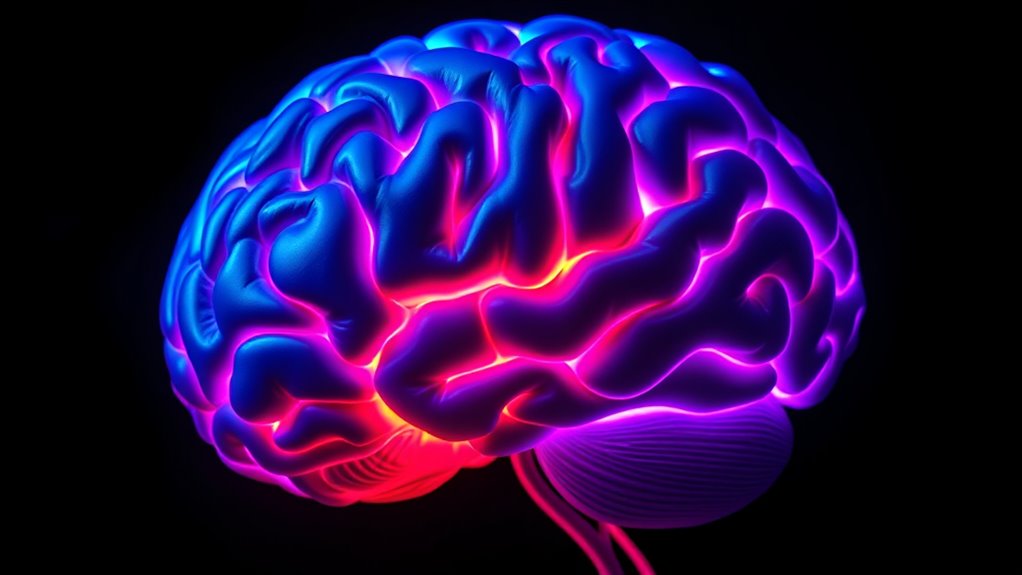The neuroscience behind narcissistic behavior involves specific brain regions like the amygdala, prefrontal cortex, and insula, which influence how people perceive themselves and handle emotions. Narcissists often show differences in brain structure and activity that affect empathy, emotional regulation, and social understanding. These neural patterns contribute to traits like self-centeredness, manipulation, and relationship instability. To explore how these brain mechanisms shape narcissism and what future research might reveal, keep exploring these fascinating insights.
Key Takeaways
- Narcissistic behavior is linked to structural and functional differences in brain regions like the amygdala, prefrontal cortex, and insula.
- Variations in neural connectivity affect self-awareness, empathy, and emotional regulation in individuals with narcissistic traits.
- Heightened amygdala activity can lead to intense emotional responses and self-focus, influencing narcissistic tendencies.
- Reduced activity in empathy-related regions, such as the anterior insula, contributes to social cognition deficits in narcissists.
- Emerging neuroimaging and AI technologies are advancing understanding of neural circuits underlying narcissistic behaviors.
Exploring the Distinctions: Grandiose vs. Vulnerable Narcissism

Understanding the differences between grandiose and vulnerable narcissism is essential because these two types manifest very differently in behavior and emotional regulation.
With grandiose narcissism, you have high self-esteem and seek dominance, often managing emotions confidently in social settings. You might crave admiration openly and appear assertive, driven by an exaggerated sense of superiority. These individuals often display self-confidence that masks underlying insecurities, which can influence their emotional responses. This overvaluation often results from developmental factors like excessive praise or reinforcement during childhood. Additionally, their sense of entitlement can lead to dismissive or exploitative interactions with others.
Conversely, vulnerable narcissists struggle with insecurity and deep sensitivities. You’re more likely to be passive, avoidant, and highly reactive to criticism. Your self-esteem tends to be low, and emotional regulation is more difficult, leading to mood swings and distress. The emotional vulnerability associated with this type can make reactions more unpredictable and intense. Recognizing these traits as stemming from developmental backgrounds can help in understanding their emotional responses better. Furthermore, their heightened sensitivity to rejection often causes them to withdraw or become defensive in social situations.
These distinctions stem from different developmental backgrounds—overvaluation for grandiose traits, neglect or criticism for vulnerable ones. Recognizing these differences helps you understand their unique behavioral patterns and emotional responses.
Additionally, the way these traits are expressed can influence your emotional regulation and your reactions to social situations, which further differentiates the two narcissistic types.
Brain Structure and Function in Narcissistic Traits
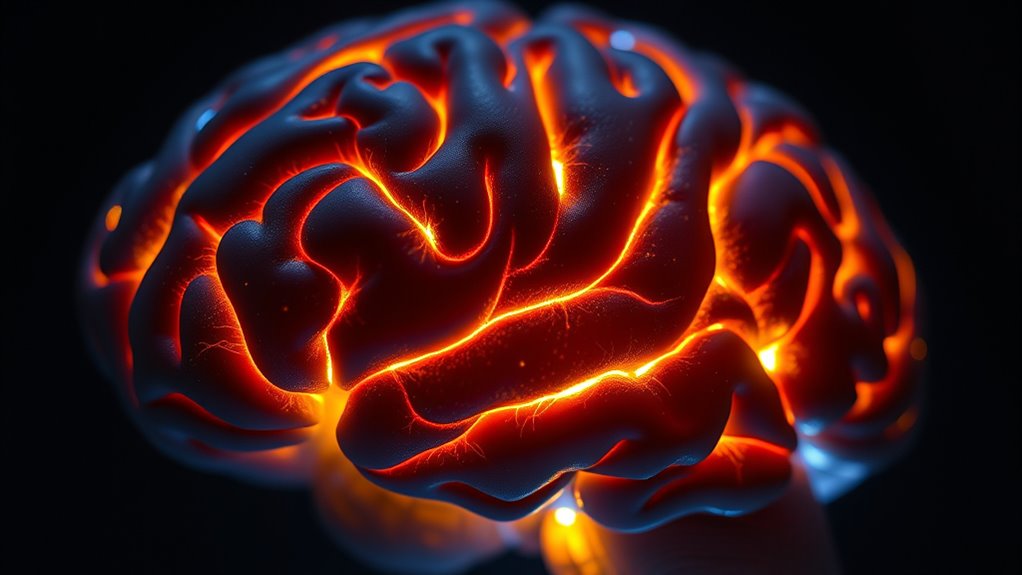
The way narcissistic traits manifest is closely linked to specific brain structures and their functions. You might notice that the amygdala, which regulates emotions, shows heightened activity, leading to intense emotional responses and self-focus. The prefrontal cortex, especially the lateral and medial areas, influences self-centered behavior and emotion regulation, often resulting in interpersonal struggles. The anterior cingulate cortex monitors conflicts and social cues, but in narcissists, its functioning may be altered, affecting social cognition. The anterior insula, tied to empathy, often exhibits reduced activity, explaining empathy deficits. Additionally, frontostriatal circuits involved in emotional control are impacted, impairing self-awareness and regulation. These structural differences and connectivity patterns contribute to the characteristic traits observed in narcissistic individuals. Understanding brain structure and function and their implications can also shed light on how individuals manage personal finance and emotional regulation, as both involve complex cognitive processes. Moreover, these neural variations can influence behavioral patterns and decision-making processes that are central to narcissistic tendencies.
The Role of Emotional Regulation and Amygdala Activity
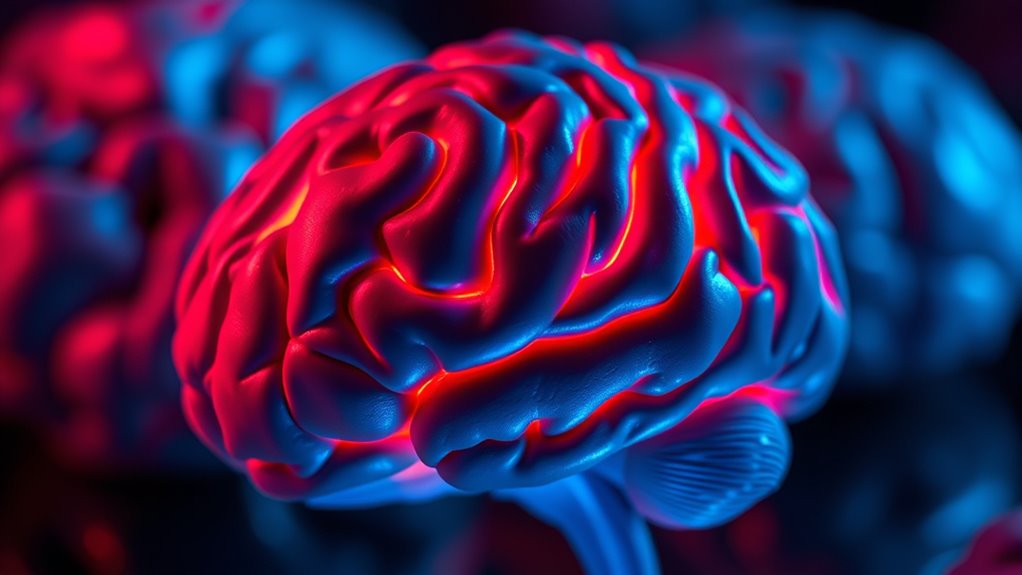
Emotional regulation in narcissism involves managing intense feelings like pride and shame to maintain self-esteem, often leading to avoidance of situations that threaten their ego. You might steer clear of emotional triggers or suppress vulnerability to protect your self-image. This tendency can be linked to differences in neural responses involved in processing emotional stimuli. Vulnerable narcissists experience significant emotional dysregulation, making it harder to control these fluctuations, while grandiose types tend to control their emotions better. Additionally, neural mechanisms involved in emotional responses are complex and extend beyond self-reporting, including stress reactions linked to ego threats. Neuroscience shows that emotional responses involve neural mechanisms beyond self-reporting, including stress reactions linked to ego threats. The amygdala, a brain structure vital for processing emotions, may function differently in narcissists, especially under stress. Furthermore, recent studies suggest that differences in amygdala activity could contribute to the emotional regulation challenges observed in narcissists. Understanding emotional processing in the brain helps explain why some individuals struggle with emotional regulation and may be more prone to narcissistic traits. While direct links are still being studied, alterations in amygdala activity could influence how narcissists perceive and react to emotional stimuli, affecting their emotional regulation. Additionally, research into the brain’s emotional mechanisms suggests that differences in neural activity may underpin some of these emotional regulation challenges.
Social Cognition and Interpersonal Challenges in Narcissists

Narcissists often demonstrate a complex interplay between social cognition and interpersonal behavior that shapes their relationships. They generally have intact perspective-taking skills, meaning they can understand others’ beliefs and desires, but their motivation to do so varies. While their ability to recognize emotions is often preserved, their emotional empathy tends to be reduced, making genuine emotional connection difficult. Narcissists frequently use social awareness to manipulate others and maintain their self-image, employing strategies like deception and manipulation. Their communication can be impulsive, sometimes aggressive, leading to unstable relationships marked by cycles of idealization and devaluation. Although they are aware of social cues, their interpersonal patterns often result in dysfunction, difficulty sustaining healthy connections, and relational instability driven by their self-centered motives and manipulative tactics. Their tendency to exploit social cognition can hinder the development of deeper emotional bonds, emphasizing the importance of understanding the mental health implications associated with narcissistic behaviors. Recognizing the social cognition skills they possess can be crucial for developing effective intervention strategies and promoting healthier interpersonal dynamics. Additionally, their focus on self-image often influences their social interactions and decision-making processes, further complicating their relational patterns. Understanding the role of vibrational energy in social interactions can offer additional insights into their behavior patterns and potential avenues for therapeutic approaches. Incorporating awareness of nonverbal cues can also enhance understanding of their true emotional state, which may differ from their verbal communication.
Key Brain Regions Implicated in Narcissistic Behavior
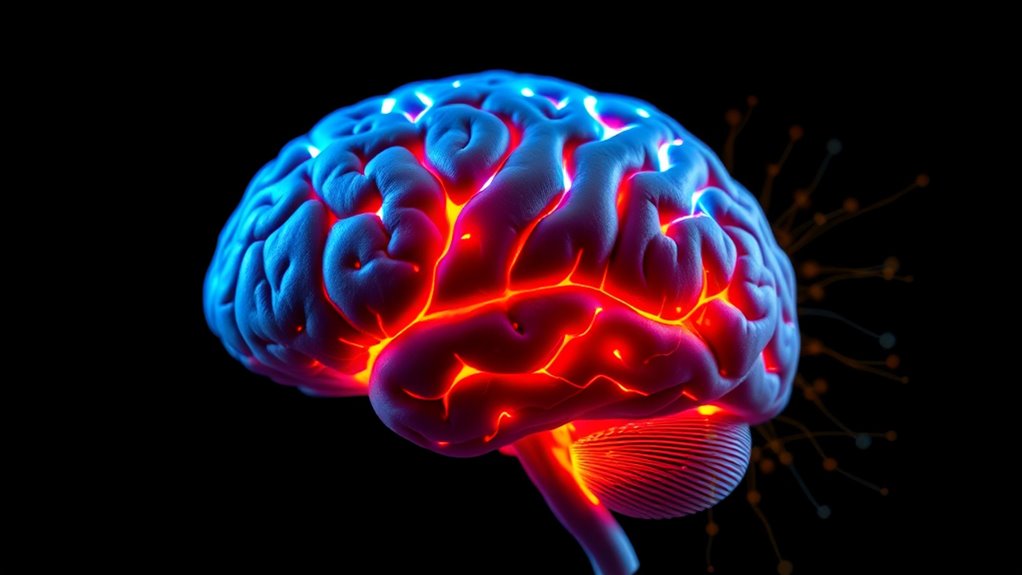
Understanding the neural basis of narcissistic behavior involves examining specific brain regions that influence self-perception, social awareness, and emotional regulation. The prefrontal cortex, especially the dorsolateral and medial areas, plays a key role in self-awareness and empathy.
Narcissistic individuals often show smaller gray matter volumes in the superior and middle frontal gyri, affecting their social cognition. These structural differences can be linked to brain structure alterations that contribute to their behavioral traits. Additionally, research indicates that variations in neuroanatomy can influence the severity and manifestation of narcissistic tendencies. Recent studies also suggest that disruptions in neural connectivity between these regions can exacerbate narcissistic behaviors, highlighting the importance of integrated neural networks. Moreover, deficits in emotional regulation are often observed in narcissistic individuals, impacting their ability to manage social interactions effectively.
The anterior insula is involved in self-referential processing and decision-making, with activity differences seen in highly narcissistic people. Functional variations in this region impact how individuals process their sense of self and their reactions to social stimuli.
The posterior cingulate cortex also varies in activity, impacting self-related thoughts. These variations influence how narcissists evaluate themselves and their relationships.
These regions form part of a network that influences how narcissists perceive themselves and others. Alterations here relate to deficits in empathy, emotional regulation, and social understanding, shaping narcissistic traits and behaviors. Understanding brain structure can shed light on the neurobiological underpinnings of these traits.
Future Directions in Neuroscience Research on Narcissism
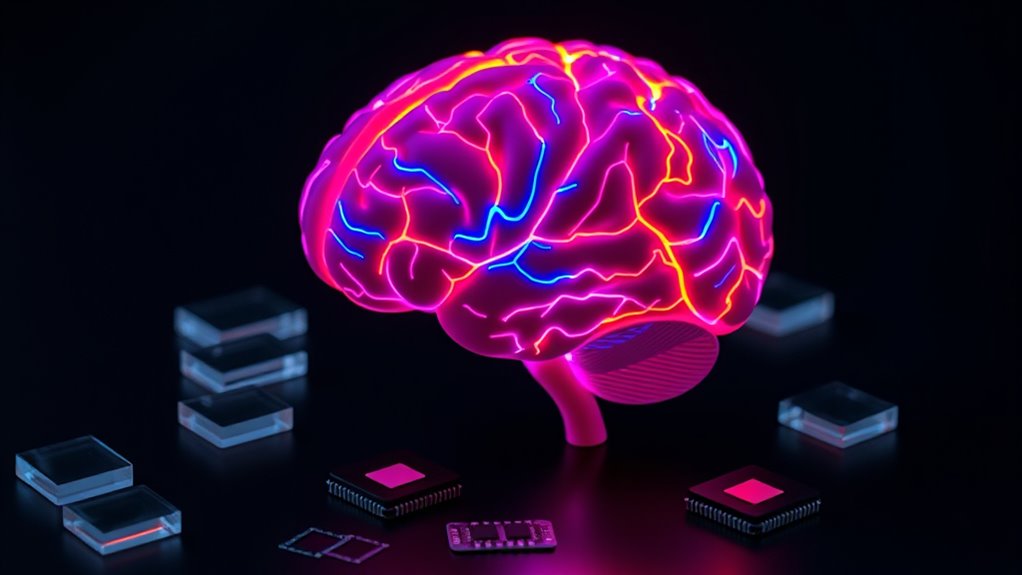
Advancements in neuroimaging techniques are poised to revolutionize how you study narcissistic behavior by providing more detailed insights into brain function. AI-driven analysis will allow for more precise mapping of brain networks involved in narcissism, while improved statistical methods enhance study reliability. Gold IRA research methods, such as high-resolution imaging, will enable scientists to examine the neural correlates of narcissistic traits more accurately. Real-time techniques like functional MRI (fMRI) will help track dynamic brain activity, deepening your understanding of how narcissistic traits fluctuate over time. Longitudinal neuroimaging studies will reveal how brain structures evolve and influence narcissistic tendencies. Researchers are also exploring genetic and neurohormonal interactions, such as dopamine and serotonin’s roles, to uncover underlying biological mechanisms. Incorporating neuroinformatics and machine learning approaches will further refine the identification of neural biomarkers associated with narcissism. These innovations will support the development of targeted interventions and biomarkers, ultimately offering more personalized strategies for understanding and managing narcissistic behaviors. Additionally, emerging brain mapping technologies will facilitate more comprehensive visualization of neural circuits involved in narcissistic traits. Moreover, ongoing research into brain plasticity suggests that certain neural pathways may be modifiable through intervention, opening new avenues for treatment. Furthermore, integrating noise reduction technology in neuroimaging equipment can significantly improve the clarity and accuracy of the captured data.
Frequently Asked Questions
How Do Neurotransmitter Levels Influence Narcissistic Behaviors?
Your neurotransmitter levels directly impact narcissistic behaviors by affecting mood, empathy, and reward processing. When serotonin is low, you might feel emotionally unstable and struggle with empathy, fueling narcissistic traits.
Dopamine influences your desire for admiration, prompting you to seek validation. Imbalances can lead to behavioral changes, impacting your relationships.
Recognizing these biological factors can help you understand and potentially manage narcissistic tendencies more effectively.
Are There Genetic Factors Linked to Narcissistic Brain Structures?
You might wonder if genetics influence brain structures linked to narcissism. Research shows that 40-60% of narcissistic traits are heritable, affecting areas like the prefrontal cortex and limbic system, which influence self-perception and emotional processing.
While no specific genes are identified, genetic variations can impact these brain regions. However, environmental factors also play a vital role, shaping how genetics express in narcissistic behaviors.
Can Neurofeedback Help Modify Narcissistic Tendencies?
You ask if neurofeedback can help modify narcissistic tendencies. While research is still preliminary, neurofeedback shows promise by training your brain to improve empathy and social skills.
It works by providing real-time feedback on your brain activity, helping you learn self-regulation. Consistent practice may reduce narcissistic behaviors over time, especially when combined with other therapies.
However, more studies are needed to confirm its long-term effectiveness.
How Does Childhood Trauma Affect Neural Development Related to Narcissism?
Ever wonder how childhood trauma shapes your brain and influences narcissism? It damages key areas like the hippocampus and amygdala, impairing emotional regulation and memory.
This makes it harder for you to process feelings like shame or guilt, often leading to narcissistic traits. Trauma also disrupts neural circuits responsible for managing emotions, which can cause you to become overly reactive, grandiose, or emotionally fragile as you grow older.
What Role Do Environmental Factors Play in Shaping Neural Narcissistic Traits?
You should understand that environmental factors profoundly shape neural narcissistic traits. When you experience indulgent parenting or lack emotional connection, your brain’s development may favor self-centered behaviors and reduced empathy.
Cultural influences, like individualism and social media, also reinforce these traits. These experiences interact with your biology, affecting brain regions involved in empathy and impulse control, ultimately influencing how narcissistic behaviors develop and are expressed in your neural pathways.
Conclusion
Understanding the neuroscience behind narcissistic behavior reveals how your brain shapes your actions and perceptions. By exploring brain structure, emotional regulation, and social cognition, you see that change is possible with awareness and effort. Remember, “the mind is like a garden; if you don’t cultivate it, weeds will grow.” With continued research, you can better grasp these complexities and work toward healthier interactions and self-awareness.

